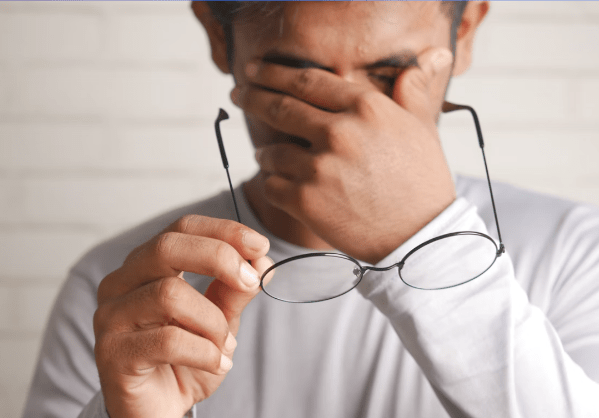In this article, we look at what eyestrain is, what causes it, and the many measures you can take to prevent it.

What Is Eyestrain?
Eyestrain is eye fatigue, caused by intensely focusing the eyes during a task, such as staring at a computer screen (or phone screen) for extended periods, driving, reading, or engaging in detailed activities, e.g. sewing or reading, and being exposed to bright light or glare, and artificial and ‘blue light’.
The symptoms of eyestrain can include watery, dry, itchy, or burning eyes, blurred vision and sensitivity to light, double vision, headache, neck, and shoulder pain, and difficulty keeping eyes open.
Having a prior condition, e.g. having dry eyes, uncorrected vision, or muscle imbalance, can increase the risk of eye strain, as can stress and fatigue.
Digital Eyestrain
The central part that technology such as digital devices – desktop and laptop computers, smartphones, tablets or e-readers, television, and video game consoles – play in our lives, coupled with factors such as working from home / remotely (working long hours and into the night, or in the wrong visual conditions), and a lack of awareness for / concern about the condition have led to the prevalence of digital eyestrain (DES), also known as computer vision syndrome (CVS).
Digital eyestrain is now common. For example, a US Vision Council survey (2020) found that 60 per cent of people have suffered from digital eyestrain.
Blue Light
The kind of ‘blue light’ emitted by digital device screens is often cited as being a contributing factor to digital eye strain, and to lack of sleep. Blue light from screens (which is also given-off by fluorescent lights) has shorter wavelengths and higher energy than other colours, and this particular kind of light has been the subject of discussions and research about whether it may contribute to issues such as retina damage, the risk of certain cancers, mental health problems, and childrens’ health problems, e.g. obesity, near-sightedness, and attention focusing issues.
How To Avoid Eyestrain
Although eyestrain itself is not serious and doesn’t have long-term consequences, it can be very uncomfortable and disruptive. It is, however, preventable and there are many different measures that can be taken to reduce the risk of eyestrain and relieve its symptoms. Examples include:
- Shut out the light. For example, break up longer periods of screen time by sitting or lying down quietly for a few minutes, closing your eyes, and focusing on your breathing. This can obviously be relaxing as well as reducing eyestrain risk.
- Use the 20-20-20 rule. After 20 minutes of looking at a screen, look 20 feet into the distance for roughly 20 seconds to relax the eyes.
- Use an eye compress and ‘palming.’ Place a cool or warm compress (e.g. cloth dipped) in cold water over the eyelids for a few minutes. Alternatively, rub your hands together to create heat and then cup your palms over your eyelids (palming).
- Take measures to block out blue light. These could include wearing blue-light-blocking glasses, changing the brightness and blue light levels in the device/computer settings, install a screen filter (on the phone), or use blue light blocking software.
- Choose a monitor with easy-to-adjust settings and ergonomic adjustments and use an adjustable chair. Adjust your screen or chair so that your eye level is at the top of the screen, and you are sitting 23 inches / 58cm (approximately) away from a screen on a desk and 14 inches / 36cm away when using a laptop
- Make sure there is proper lighting in the room and arrange the room to avoid glare from uncovered windows, lamps, and overhead light fixtures. Also, be aware that air conditioning units which can dry the eyes.
- Increase the font size or zoom percentage size on the screen when working.
- Take regular breaks away from the device.
- Pay attention to posture, i.e. sit up straight rather than leaning back or forward – too close or too far away from the screen.
- Use eye exercises to help reduce the symptoms of eye strain, e.g. moving a pen towards and away from the eyes while focusing on it, and jumping between focusing on looking at pen close by and a fixation point 3 to 4 metres away (as suggested by Specsavers).
- Take care to blink more often. Research has shown that staring at the screen too long can result in less blinking. Normal blinking ensures that the eyes are moistened, thereby preventing dryness and irritation.
- Have regular, comprehensive eye tests and consider the benefits of getting customised computer glasses from your optician.
What Does This Mean For Your Business?
So much of our work and home life now involves looking at the screens of different devices, often for long periods of time, in different locations, in the day and at night. All these factors can contribute to eyestrain, which research shows 6 out of 10 people have suffered from. In addition to being extremely uncomfortable, it can disrupt work and affect productivity and morale.
For businesses in an office setting, it is a case of providing the correct and up-to-date equipment, e.g. fully adjustable monitors and chairs, as well as the appropriate lighting, and giving advice as well as allowing for (and encouraging) breaks from screen time.
With remote and hybrid working, businesses can also help by reminding and providing information to workers about how to avoid the risk of eyestrain when working at home and in other settings.
By Mike Knight
